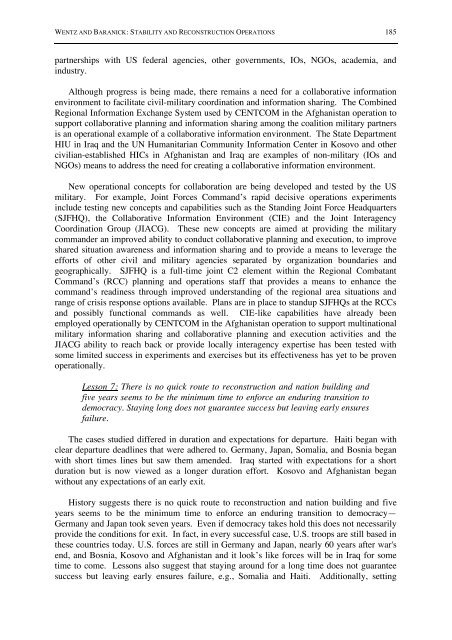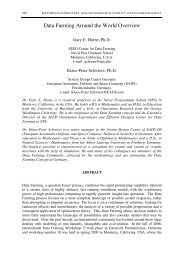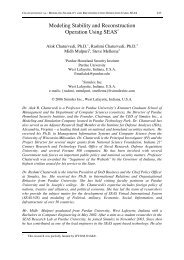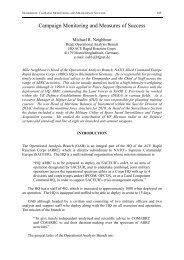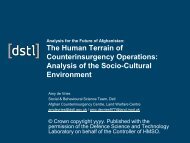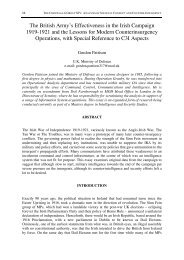Stability and Reconstruction Operations: What ... - Cornwallis Group
Stability and Reconstruction Operations: What ... - Cornwallis Group
Stability and Reconstruction Operations: What ... - Cornwallis Group
You also want an ePaper? Increase the reach of your titles
YUMPU automatically turns print PDFs into web optimized ePapers that Google loves.
WENTZ AND BARANICK: STABILITY AND RECONSTRUCTION OPERATIONS 185<br />
partnerships with US federal agencies, other governments, IOs, NGOs, academia, <strong>and</strong><br />
industry.<br />
Although progress is being made, there remains a need for a collaborative information<br />
environment to facilitate civil-military coordination <strong>and</strong> information sharing. The Combined<br />
Regional Information Exchange System used by CENTCOM in the Afghanistan operation to<br />
support collaborative planning <strong>and</strong> information sharing among the coalition military partners<br />
is an operational example of a collaborative information environment. The State Department<br />
HIU in Iraq <strong>and</strong> the UN Humanitarian Community Information Center in Kosovo <strong>and</strong> other<br />
civilian-established HICs in Afghanistan <strong>and</strong> Iraq are examples of non-military (IOs <strong>and</strong><br />
NGOs) means to address the need for creating a collaborative information environment.<br />
New operational concepts for collaboration are being developed <strong>and</strong> tested by the US<br />
military. For example, Joint Forces Comm<strong>and</strong>’s rapid decisive operations experiments<br />
include testing new concepts <strong>and</strong> capabilities such as the St<strong>and</strong>ing Joint Force Headquarters<br />
(SJFHQ), the Collaborative Information Environment (CIE) <strong>and</strong> the Joint Interagency<br />
Coordination <strong>Group</strong> (JIACG). These new concepts are aimed at providing the military<br />
comm<strong>and</strong>er an improved ability to conduct collaborative planning <strong>and</strong> execution, to improve<br />
shared situation awareness <strong>and</strong> information sharing <strong>and</strong> to provide a means to leverage the<br />
efforts of other civil <strong>and</strong> military agencies separated by organization boundaries <strong>and</strong><br />
geographically. SJFHQ is a full-time joint C2 element within the Regional Combatant<br />
Comm<strong>and</strong>’s (RCC) planning <strong>and</strong> operations staff that provides a means to enhance the<br />
comm<strong>and</strong>’s readiness through improved underst<strong>and</strong>ing of the regional area situations <strong>and</strong><br />
range of crisis response options available. Plans are in place to st<strong>and</strong>up SJFHQs at the RCCs<br />
<strong>and</strong> possibly functional comm<strong>and</strong>s as well. CIE-like capabilities have already been<br />
employed operationally by CENTCOM in the Afghanistan operation to support multinational<br />
military information sharing <strong>and</strong> collaborative planning <strong>and</strong> execution activities <strong>and</strong> the<br />
JIACG ability to reach back or provide locally interagency expertise has been tested with<br />
some limited success in experiments <strong>and</strong> exercises but its effectiveness has yet to be proven<br />
operationally.<br />
Lesson 7: There is no quick route to reconstruction <strong>and</strong> nation building <strong>and</strong><br />
five years seems to be the minimum time to enforce an enduring transition to<br />
democracy. Staying long does not guarantee success but leaving early ensures<br />
failure.<br />
The cases studied differed in duration <strong>and</strong> expectations for departure. Haiti began with<br />
clear departure deadlines that were adhered to. Germany, Japan, Somalia, <strong>and</strong> Bosnia began<br />
with short times lines but saw them amended. Iraq started with expectations for a short<br />
duration but is now viewed as a longer duration effort. Kosovo <strong>and</strong> Afghanistan began<br />
without any expectations of an early exit.<br />
History suggests there is no quick route to reconstruction <strong>and</strong> nation building <strong>and</strong> five<br />
years seems to be the minimum time to enforce an enduring transition to democracy—<br />
Germany <strong>and</strong> Japan took seven years. Even if democracy takes hold this does not necessarily<br />
provide the conditions for exit. In fact, in every successful case, U.S. troops are still based in<br />
these countries today. U.S. forces are still in Germany <strong>and</strong> Japan, nearly 60 years after war's<br />
end, <strong>and</strong> Bosnia, Kosovo <strong>and</strong> Afghanistan <strong>and</strong> it look’s like forces will be in Iraq for some<br />
time to come. Lessons also suggest that staying around for a long time does not guarantee<br />
success but leaving early ensures failure, e.g., Somalia <strong>and</strong> Haiti. Additionally, setting


